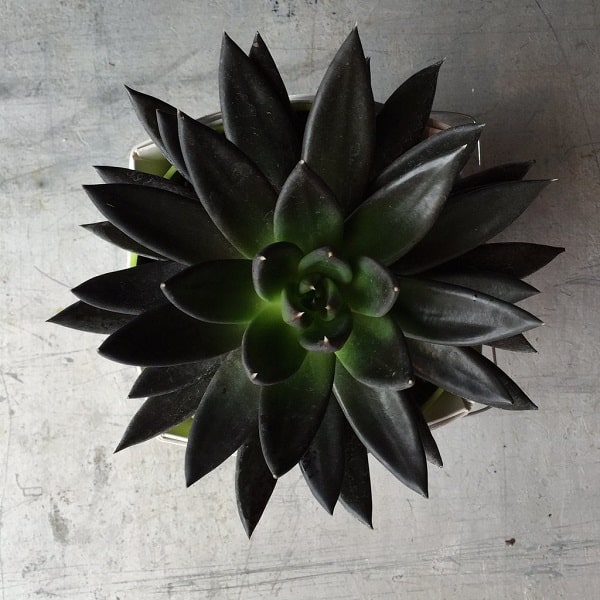The Black Prince Succulent is a very beautiful and different plant, which makes it ideal for adding to any plant collection.
It is an evergreen plant, which measures 15 cm high and 21 cm wide.
The black prince is characterized by forming rosettes of fairly compact leaves of about 16 cm in diameter and about 8 cm in height.
Its rosettes grow slowly unlike other succulent species of the same genus.
The leaves that are at the base of the stem will dry, leaving it completely naked.
After this same area, new rosettes will begin to form, which will give new plants, forming individual roots that will allow the possibility of planting a new plant, in case the main rosette dies.
It is native from Mexico.
Within its quality, it is a hybrid and one of the most cultivated Echeveria by lovers of this genre.
It can be grown in pots, planters or rockeries.
It will highlight greatly in containers to form ornamental arrangements.
This succulent is not the easiest to grow in the garden, but it is not the most complicated.
You just need to follow the advice to take care of this plant:
Tips to take care of the black prince succulent
Illumination
Black prince succulent prefers to grow in well-lit places where it receives filtered, but not direct, sunlight.
Just tolerate the morning sun and late afternoon. Just be careful with the intense midday sun. because it can burn the foliage.
Temperatures
It needs to develop in climates where temperatures are between 18⁰C-28⁰C.
It does not tolerate temperatures below 5⁰C for long periods.
Substratum
This plant must be sown in a very aerated substrate with optimum drainage.
Like most succulents, this plant is very susceptible to rotting if water stagnates in the substrate.
Watering
The Black Prince has the typical irrigation needs of a succulent.
For this type of plants, it is better to use the “soaking and drying” method, that is to let the soil dry between irrigation and irrigation.
Watering should always be deep but avoiding pooling in the substrate.
And the lack of irrigation can cause the dryness of the basal leaves and wrinkle of all the others.
Plagues and diseases
Black prince succulent is mainly affected by mealybugs and mollusks.
It can also be attacked by pathogenic fungi that cause rapid wilting of leaves and rot.
Propagation
The black prince succulent easily multiplies from the separation of rosettes that form at the base of the plant.
Also by inflorescence leaves.
To cut a ‘Black Prince’, use a sharp knife or scissors, after which the cut becomes insensitive, that is, let the plant rest for a few days before planting in a soil with good drainage.
Flowers
The black prince succulent produces red flowers in late autumn until early winter.
The flowers are arranged in long cluster inflorescences that arise from the sides of the rosettes as in all plants of the genus.
This inflorescence can exceed 30 cm in height and form more than 10 flower buds.
The flowers have 5 triangular segments that form a lantern-like structure and exhibit an orange coloration.
The stem of the inflorescence has a light green coloration but the leaves that form on it show a coloration very similar to that of the rosette leaves.
Leaves
The leaves have a linear-lanceolate or slightly spatulated shape, measuring about 10 cm long and about 4 cm wide.
They have a very sharp apex (the leaf narrows so much that it looks like a terminal spine), the margin is whole, they are very fleshy and exhibit a reddish-violet coloration with greenish tones towards the center.
The coloration in this plant is further accentuated if it is exposed to sources of intense illumination, that is, under filtered sunlight, its leaves will be darker, while, in low lighting sites, they will be greener.
Flowerpot
It can be in a small pot, although if the plant no longer fits in the pot, it is advisable to transplant it into a larger pot since it can develop larger rosettes. up to 25cm in diameter.
Prune the plant
This plant does not need to be pruned, you just have to remove the damaged or rotten leaves.
Fertilizer
Succulents do not show great nutritional needs.
Only those that come in a pot can require fertilization, although always with moderation, and especially to stimulate flowering.
It is advisable to use specific fertilizers for cacti and succulents from March to September and always apply them on the moistened substrate, respecting the dose and frequency indicated on the fertilizer container.
To avoid rot after rains it is advisable to treat them with Funcida Copper Cuper Plus (preventive) or Triadimenol 25% 20 CC Blangueta (systematic, preventive and curative).
Conclusion
After knowing the low maintenance of this plant, it becomes even more ideal to have it in any garden and give an exotic touch to our collection.
Especially since they are plants that do not take up much space and we can have it inside our house or office, just making sure that it receives sunlight.
